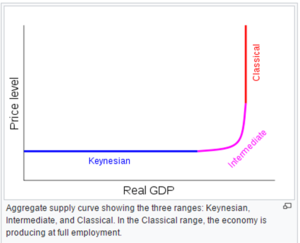Aggregate Supply
Aggregate supply (AS) is defined as the total amount of goods and services (real output) produced and supplied by an economy’s firms over a period of time. It includes the supply of a number of types of goods and services including private consumer goods, capital goods, public and merit goods and goods for overseas markets.[1]
Rising prices are usually signals for businesses to expand production to meet a higher level of aggregate demand. When demand increases amid constant supply, consumers compete for the goods available and therefore pay higher prices. This change in dynamic induces firms to increase supply output to sell more goods. The resulting supply increase causes prices to normalize and output to remain elevated. A shift in aggregate supply can be attributed to a number of variables. These include changes in the size and quality of labor, technological innovations, increase in wages, increase in production costs, changes in producer taxes and subsidies, and changes in inflation. Some of these factors lead to positive changes in aggregate supply, while others cause aggregate supply to decline. For example, increased labor efficiency, perhaps through outsourcing or automation, raises supply output by decreasing the labor cost per unit of supply. By contrast, wage increases - prevalent in many areas of the U.S. as of 2016 - place downward pressure on aggregate supply by increasing production costs.[2]

source:Wikipedia
There are two main reasons why the amount of aggregate output supplied might rise as P rises, i.e., why the AS curve is upward sloping:
- The short run AS curve is drawn given some nominal variables such as the nominal wage rate, which is assumed fixed in the short run. Thus, a higher price level P implies a lower real wage rate and thus an incentive to produce more output. In the neoclassical long run, on the other hand, the nominal wage rate varies with economic conditions. (High unemployment leads to falling nominal wages which restore full employment.) Hence in the long run the aggregate supply curve is vertical.
- An alternative model starts with the notion that any economy involves a large number of heterogeneous types of inputs, including both fixed capital equipment and labor. Both main types of inputs can be unemployed. The upward-sloping AS curve arises because
- (1) some nominal input prices are fixed in the short run and
- (2) as output rises, more and more production processes encounter bottlenecks.
At low levels of demand, there are large numbers of production processes that do not use their fixed capital equipment fully. Thus, production can be increased without much in the way of diminishing returns and the average price level need not rise much (if at all) to justify increased production. The AS curve is flat. On the other hand, when demand is high, few production processes have unemployed fixed inputs. Thus, bottlenecks are general. Any increase in demand and production induces increases in prices. Thus, the AS curve is steep or vertical.
Aggregate supply is targeted by government "supply side policies" which are meant to increase productive efficiency and hence national output. Some examples of supply side policies include: education and training, research and development, supporting small/medium entrepreneurs, decreasing business taxes, making labor market reforms to diminish frictions that may hold down output, and investing in infrastructure.[3]
See Also
- Aggregate Demand - Discusses the total demand for all goods and services within an economy at a given overall price level and in a given time period.
- Supply and Demand - Explores the basic economic model of price determination in markets and how these two forces interact to determine equilibrium prices and quantities.
- Macroeconomic Equilibrium - Reviews the condition where aggregate supply equals aggregate demand, explaining its significance for the overall economy.
- Inflation - Covers the rate at which the general level of prices for goods and services is rising, eroding purchasing power.
- Unemployment - Discusses the phenomenon where individuals who are capable of working and are actively seeking work remain un-hired.
- Monetary Policy - Explores the process by which the monetary authority of a country controls the supply of money, often targeting an inflation rate or interest rate to ensure economic stability and growth.
- Fiscal Policy - Reviews government spending policies that influence macroeconomic conditions, including tax policies, spending programs, and budget priorities.
- Business Cycles - Discusses the fluctuations in economic activity that an economy experiences over a period of time, including expansions and contractions.
- Long-Run Aggregate Supply (LRAS) - Covers the total quantity of goods and services that an economy can produce when both capital and labor are fully employed.
- Short-Run Aggregate Supply (SRAS) - Explores the total quantity of goods and services that producers in an economy are willing and able to supply at a given overall price level in the short term.
- Phillips Curve - Discusses the historical inverse relationship between rates of unemployment and corresponding rates of inflation that result within an economy.
- Economic Growth - Reviews the increase in the inflation-adjusted market value of the goods and services produced by an economy over time.
- Stagflation - Covers the situation in which the inflation rate is high, the economic growth rate slows, and unemployment remains steadily high.
- Productivity - Discusses the efficiency of production of goods and services in the economy, often measured as output per unit of input.
- International Trade and Aggregate Supply - Explores how international trade affects aggregate supply through the availability of imports and exports, influencing domestic production levels and prices.
References
- ↑ Aggregate supply Definition Economics Online
- ↑ BREAKING DOWN Aggregate Supply investopedia
- ↑ Aggregate Supply AnalysisWikipedia
Further Reading
- Aggregate Supply in the Economy: Definition and Determinants study.com
- Aggregate Supply and Depression Economics NY Times/Krugman
